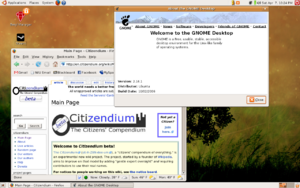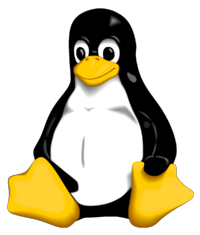Linux (operating system)
| Linux |

|
| The GNOME desktop on Ubuntu Linux 6.10 |
| Website: http://www.kernel.org/ (Official site for Linux kernel development) |
| Created by: Linus Torvalds (Linux kernel) and Richard Stallman (GNU Utilities) |
| Developer: The Open Source community |
| OS family: Unix-like |
| Source model: Open source |
| Supported platforms: AMD64, ARM, DEC Alpha, HP PA-RISC, IA-64, MIPS, Motorola 68k, PowerPC, IBM S/390, Sun SPARC, x86, x86-64 |
| Kernel type: Modular monolithic |
| Default user interface (most distros): GUI |
| License: GNU General Public License |
| Working state: Current |

The term Linux in conversation usually refers to a "Unix-like" open source operating system and the GNU utilities distributed with it. Strictly the term "Linux" refers to just the kernel. A Linux distribution is in fact a complete operating system bundled together, and is what people usually are referring to when the term "Linux" is used.
The surge in the popularity of Linux in the past decade has contributed to the popularity of open source software in general, and brought the ideals and methodologies of both the open source crowd and the free software movement into the limelight.
History
Development of the Linux kernel was started in 1991 by a Finnish college student named Linus Torvalds. At the time, the majority of Unix systems were very expensive. The only affordable workstation environment was a proprietary system called Minix. Although the source code was included with this system, the license fee was still a bit pricey, and it was not as robust or feature complete as the systems the workstations in the universities were running.
The name
Originally, Torvalds had intended to call the system Freax, for Free, Freaks, and Unix. The original source code up to version 0.11 made reference to this, such as a comment in the Makefile, "Makefile for the freax kernel". However, the kernel's FTP directory at nic.funet.fi was named Linux, in honor of its creator, of course, with an x to denote that it is Unix-like. This name caught on, and has been the official alias ever since. Linux is pronounced like 'Minix' - that is, "'li' is pronounced with a short [ee] sound: compare prInt, mInImal etc.'nux' is also short, non-diphtong, like in pUt."[1]
GNU/Linux controversy
By strict definition, it is rarely seen by the user, because its job is to be a layer between the user environment and the hardware. While first began his project, the Free Software Foundation (FSF), led by Dr. Richard Stallman, was also developing a free operating system called GNU, which is a recursive acronym for GNU's Not Unix. The GNU system's development began with the necessary tools for the project, such as a compiler (GNU C Compiler) and a text editor (Emacs), and eventually began writing their kernel - that is, the core of the operating system - after they had finished writing the tools to place above it. Due to the very complex structure they chose to implement, however, the team had a very hard time getting the system to run. In effect, the GNU system became vaporware, leaving free software enthusiasts to use Linux. Because the Linux kernel was usually used in conjunction with the tools the FSW created for GNU, the FSF refers to complete Linux operating systems as GNU/Linux. This convention has been very controversial, however. Torvalds has made no effort to hide his thoughts towards this naming convention, however, saying that "calling Linux in general just 'GNU/Linux' I think is ridiculous."[2]
Interface
The majority of Linux distributions allow the use of both a GUI (Graphical User Interface) and a CLI (Command Line Interface). In the st few years, many distributions have focused on improving the graphical interface to increase the accessibility of the interface to new users. Ubuntu, widely believed to be the most used Linux distribution, is going to have a complete visual refresh for its next release [3].
Desktop environments
There are many desktop environments available for Linux. However, the two most popular are GNOME and KDE.
GNOME
GNOME is a desktop environment focused on easy of use. The most recent stable release is 2.20. The main distribution that uses GNOME is Ubuntu.
KDE
KDE is another desktop environment, but is focused on allowing the user to configure as much as possible. The main distributions that use KDE are Kubuntu and MEPIS. Soon, the KDE developers are releasing a major milestone: KDE4, which is to be released on 11 January 2007. Most of the environment is being upgraded to the Qt4 toolkit, and increases in speed over KDE3 are planned. A new theme, known as the "Oxygen icon set", will be included.
Xfce
Xfce is a desktop environment designed to give a compromise between eye candy and speed. The latest release is 4.4.1. Several distributions use Xfce as the default desktop environment, including Dreamlinux and Zenwalk.
Fluxbox
Fluxbox is a lightweight desktop environment, aimed at low-end computers. It is designed for speed, but allows eye-candy including transparency.
Package Management
There are several different package management systems for Linux. Since most applications are open source, packages can be installed by compilation from source code. Some distributions aimed at experts use this format, including Gentoo and Sabayon Linux. However, most Linux distributions have binary packages available for download. Debian and Debian-based distributions (including Ubuntu) use the .deb pacakge format, along wth the "APT" package manager. This allows packages to be upgraded, removed and installed, dealing with all of the dependencies. Other distributions use the .rpm format. However, this package format was initially unpopular due to its poor handling of dependencies (known as "dependency hell"). OpenSUSE, Mandriva and Fedora Core all use the .rpm package format.
References
- ↑ Linus Torvalds (Accessed April 23rd, 2007). How to pronounce "Linux"?.
- ↑ The "GNU/Linux" and "Linux" Controversy (Retrieved April 6th, 2007).
- ↑ Ubuntu to get visual refresh with Hardy Heron